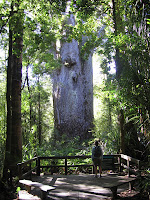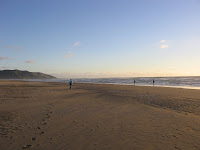
Opononi itself is a beach town bounded on one side by a beautiful bay and the ocean on the other. The sand dunes on the headlands are some of the biggest that I have ever seen. If we had more time we would have taken the water ferry over to them and sand boarded down the dunes. Sounded like a lot of fun to me. Not so much to Lana.
The hills in the northland are, well, hilly. There tend to be a lot of them and while they are not large by BC standards but they do make for twisty turning roads. Once again the standard speed limit was 100 km but nobody is doing over 80km and frequently only about 60 km. My left arm, which is my new shifting arm, is developing rapidly.
The landscape reminds me of
One thing that has been missing, compared to my visit over 20 years ago, is the sheep. Back then there were literally sheep everywhere and now all we see is mostly dairy cattle. The locals have told me that everyone got out of sheep years ago due to a bad wool market but it still looks strange and not quite right. My completely unscientific theory is that the cattle are quietly eating the sheep at night. By day they look harmless but at night….. There is probably a bad horror mo
vie script in that somewhere.
 On the way down the west coast, we stopped to walk into the forest to see the largest Kauri trees now growing in
On the way down the west coast, we stopped to walk into the forest to see the largest Kauri trees now growing in
The trees are in a 15,000 hectare reserve (what they call parks) and it was preserved only because it was the most difficult area to get at for commercial logging. It took 70,000 people, signing a petition in 1952, to get the area declared off limits to logging.
After we descended from the reserve, on really narrow roads, we hit some more open areas near Dargaville. It is at the meeting of two rivers and once was an important logging town. Oddly e
nough at the museum at Dargaville they have the masts from the Rainbow Warrior, the Greenpeace ship sunk in
After that we drove south thru
The hostel was empty except for us and we walked the beach as the sun went down in the water. Other than a few surf fishermen and a couple of gulls it was just us.
Geez that sounds romantic doesn’t it but what really happened is that we walked a really long way on the beach. Lana floated on top of the sand and I sunk in it. Great beach but I found myself wishing for a pair of snowshoes.

No comments:
Post a Comment